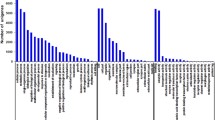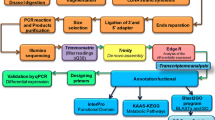Abstract
Chlamys farreri is an economically important mollusk that can accumulate excessive amounts of cadmium (Cd). Studying the molecular mechanism of Cd accumulation in bivalves is difficult because of the lack of genome background. Transcriptomic analysis based on high-throughput RNA sequencing has been shown to be an efficient and powerful method for the discovery of relevant genes in non-model and genome reference-free organisms. Here, we constructed two cDNA libraries (control and Cd exposure groups) from the digestive gland of C. farreri and compared the transcriptomic data between them. A total of 227 673 transcripts were assembled into 105 071 unigenes, most of which shared high similarity with sequences in the NCBI non-redundant protein database. For functional classification, 24 493 unigenes were assigned to Gene Ontology terms. Additionally, EuKaryotic Ortholog Groups and Kyoto Encyclopedia of Genes and Genomes analyses assigned 12 028 unigenes to 26 categories and 7 849 unigenes to five pathways, respectively. Comparative transcriptomics analysis identified 3 800 unigenes that were differentially expressed in the Cd-treated group compared with the control group. Among them, genes associated with heavy metal accumulation were screened, including metallothionein, divalent metal transporter, and metal tolerance protein. The functional genes and predicted pathways identified in our study will contribute to a better understanding of the metabolic and immune system in the digestive gland of C. farreri. In addition, the transcriptomic data will provide a comprehensive resource that may contribute to the understanding of molecular mechanisms that respond to marine pollutants in bivalves.
Similar content being viewed by others
References
Bannon D I, Abounader R, Lees P S J, Bressler J P. 2003. Effect of DMT1 knockdown on iron, cadmium, and lead uptake in Caco-2 cells. Am. J. Physiol. Cell Physio., 284 (1): C44–C50.
Chelomin V P, Bobkova E A, Lukyanova O N, Chekmasova N M. 1995. Cadmium-induced alterations in essential trace element homoeostasis in the tissues of scallop Mizuhopecten yessoensis. Comp. Biochem. Phys. C, 110 (3): 329–335.
Faria M, Carrasco L, Diez S, Riva M C, Bayona J M, Barata C. 2009. Multi-biomarker responses in the freshwater mussel Dreissena polymorpha exposed to polychlorobiphenyls and metals. Comp. Biochem. Phys. C, 149 (3): 281–288.
Garber M, Grabherr M G, Guttman M, Trapnell C. 2011. Computational methods for transcriptome annotation and quantification using RNA-seq. Nat. Methods, 8 (6): 469–477.
Gavery M R, Roberts S B. 2012. Characterizing short read sequencing for gene discovery and RNA-Seq analysis in Crassostrea gigas. Comp. Biochem. Phys. D, 7 (2): 94–99.
Geret F, Cosson R P. 2002. Induction of specific isoforms of metallothionein in mussel tissues after exposure to cadmium or mercury. Arch. Environ. Con tam. Tox icol., 42 (1): 36–42.
Gupta S C, Sharma A, Mishra M, Mishra R K, Chowdhuri D K. 2010. Heat shock proteins in toxicology: how close and how far?. Life Sci., 86 (11-]3): 377–384.
Hasselberg L, Meier S, Svardal A, Hegelund T, Celander M C. 2004. Effects of alkylphenols on CYP1A and CYP3A expression in first spawning Atlantic cod (Gadus morhua). Aquat. Toxicol., 67 (4): 303–313.
Haynes D, Johnson J E. 2000. Organochlorine, heavy metal and polyaromatic hydrocarbon pollutant concentrations in the Great Barrier Reef (Australia) environment: a review. Mar. Pollut. Bull., 41 (7-]3): 267–278.
He L, Wang Q, Jin X K, Wang Y, Chen L L, Liu L H, Wang Y. 2012. Transcriptome profiling of testis during sexual maturation stages in Eriocheir sinensis using Illumina sequencing. PLoS One, 7 (3): e33735.
Hegelund T, Celander M C. 2003. Hepatic versus extrahepatic expression of CYP3A30 and CYP3A56 in adult killifish (Fundulus heteroclitus). Aquat. Toxicol., 64 (3): 277–291.
Hou R, Bao Z M, Wang S, Su H L, Li Y, Du H X, Hu J J, Wang S, Hu X L. 2011. Transcriptome sequencing and De Novo analysis for yesso scallop (Patinopecten yessoensis) using 454 GS FLX. PLoS One, 6 (6): e21560.
Hsu J C, Chien T Y, Hu C C et al. 2012. Discovery of genes related to insecticide resistance in Bactrocera dorsalis by functional genomic analysis of a De Novo assembled transcriptome. PLoS One, 7 (8): e40950.
Iwanaga S, Lee B L. 2005. Recent advances in the innate immunity of invertebrate animals. J. Biochem. Mol. Biol., 38 (2): 128–150.
Kaminska B. 2005. MAPK signalling pathways as molecular targets for anti-inflammatory therapy-from molecular mechanisms to therapeutic benefits. B iochim. B iophys. A cta, 1754 (1-2): 253–262.
Kanehisa M, Goto S, Furumichi M, Tanabe M, Hirakawa M. 2010. KEGG for representation and analysis of molecular networks involving diseases and drugs. Nucleic Acids Res., 38 (1): D355–D360.
Kingtong S, Chitramvong Y, Janvilisri T. 2007. ATP-binding cassette multidrug transporters in Indian-rock oyster Saccostrea forskali and their role in the export of an environmental organic pollutant tributyltin. Aquat. Toxicol., 85 (2): 124–132.
Kumar S, Boehm J, Lee J C. 2003. p38 MAP kinases: key signalling molecules as therapeutic targets for inflammatory diseases. Nat. Rev. Drug Discov., 2 (9): 717–726.
Lecoeur S, Videmann B, Berny P. 2004. Evaluation of metallothionein as a biomarker of single and combined Cd/Cu exposure in Dreissena polymorpha. Environ. Res., 94 (2): 184–191.
Livak K J, Schmittgen T D. 2001. Analysis of relative gene expression data using real-time quantitative PCR and the 2-ΔΔCT method. M ethods, 25 (4): 402–408.
Luckenbach T, Epel D. 2008. ABCB-and ABCC-type transporters confer multixenobiotic resistance and form an environment-tissue barrier in bivalve gills. Am. J. Physiol. Reg ul. Integr. Comp. Physiol., 294 (6): R1919–R1929.
Lukyanova O N, Khotimchenko Y S. 1995. Lipid peroxidation in organs of the scallop Mizuhopecten yessoensis and seaurchin Strongylocentrotus intermedius during the reproductive cycle. Comp. Biochem. Phys. B, 110 (2): 371–377.
Meng X L, Liu M, Jiang K Y, Wang B J, Tian X, Sun S J, Luo Z Y, Qiu C W, Wang L. 2013. De Novo characterization of Japanese scallop Mizuhopecten yessoensis transcriptome and analysis of its gene expression following cadmium exposure. PLoS One, 8 (5): e64485.
Meng X L, Tian X, Liu M, Nie G X, Jiang K Y, Wang B J, Wang L. 2014. The transcriptomic response to copper exposure by the gill tissue of Japanese scallops (Mizuhopecten yessoensis) using deep-sequencing technology. Fish Shellfish Immun ol., 38 (2): 287–293.
Meucci V, Arukwe A. 2006. The xenoestrogen 4-nonylphenol modulates hepatic gene expression of pregnane X receptor, aryl hydrocarbon receptor, CYP3A and CYP1A1 in juvenile Atlantic salmon (Salmo salar). Comp. Biochem. Phys. C, 142 (1-2): 142–150.
Moreira R, Balseiro P, Planas J V, Fuste B, Beltran S, Novoa B, Figueras A. 2012. Transcriptomics of In vitro immunestimulated hemocytes from the manila clam Ruditapes philippinarum using high-throughput sequencing. PloS One, 7 (4): e35009.
Mortazavi A, Williams B A, McCue K, Schaeffer L, Wold B. 2008. Mapping and quantifying mammalian transcriptomes by RNA-Seq. Nat. Methods, 5 (7): 621–628.
Nagashima K, Sato M, Kawamata K, Nakamura A, Ohta T. 2005. Genetic structure of Japanese scallop population in Hokkaido, analyzed by mitochondrial haplotype distribution. Mar. Biotechnol., 7 (1): 1–10.
Olsson P E, Larsson Å, Maage A, Haux C, Bonham K, Zafarullah M, Gedamu L. 1989. Induction of metallothionein synthesis in rainbow trout, Salmo gairdneri, during long-term exposure to waterborne cadmium. Fish Physiol. Biochem., 6 (4): 221–229.
Ou J T, Meng Q G, Li Y et al. 2012. Identification and comparative analysis of the Eriocheir sinensis microRNA transcriptome response to Spiroplasma eriocheiris infection using a deep sequencing approach. Fish Shellfish Immun ol., 32 (2): 345–352.
Peng S T, Hu Y D, Bai Z P. 2009. Pollution assessment and ecological risk evalution for heavy metals in the sediments of Bohai Bay. J. Waterway Harb., 30 (1): 57–60. (in Chinese with English abstract)
Ricachenevsky F K, Menguer P K, Sperotto R A, Williams L E, Fett J P. 2013. Roles of plant metal tolerance proteins (MTP) in metal storage and potential use in biofortification strategies. Front. Plant Sci., 4: 144.
Rice P, Longden I, Bleasby A. 2000. EMBOSS: the European molecular biology open software suite. Trends Genet., 16 (6): 276–277.
Sato M, Kawamata K, Zaslavskaya N et al. 2005. Development of microsatellite markers for Japanese scallop (Mizuhopecten yessoensis) and their application to a population genetic study. Mar. Biotechnol., 7 (6): 713–728.
Schulz M H, Zerbino D R, Vingron M, Birney E. 2012. Oases: robust de novo RNA-seq assembly across the dynamic range of expression levels. Bioinformatics, 28 (8): 1086–1092.
Shan Z G, Li H J, Bao X B et al. 2011. A selenium-dependent glutathione peroxidase in the Japanese scallop, Mizuhopecten yessoensis: cDNA cloning, promoter sequence analysis and mRNA expression. Comp. Biochem. Phys. B, 159 (1): 1–9.
Slobodskova V V, Zhukovskaya A F, Chelomin V P. 2012. DNA damage in the gill cells of the marine scallop Mizuhopecten yessoensis during anoxic stress and aerobic recovery. Ocean Sci. J., 47 (2): 95–100.
Stajich J E, Block D, Boulez K et al. 2002. The Bioperl toolkit: Perl modules for the life sciences. Genome Res., 12 (10): 1611–1618.
Torres M A, Barros M P, Campos S C G, Pinto E, Rajamani S, Sayre R T, Colepicolo P. 2008. Biochemical biomarkers in algae and marine pollution: a review. Ecotox icol. Environ. Saf., 71 (1): 1–15.
Vaccaro E, Giorgi M, Longo V, Mengozzi G, Gervasi P G. 2003. Inhibition of cytochrome p450 enzymes by enrofloxacin in the sea bass (Dicentrarchus labrax). Aquat. Toxicol., 62 (1): 27–33.
Wang L K, Feng Z X, Wang X, Wang X W, Zhang X G. 2010. DEGseq: an Rpackage for identifying differentially expressed genes from RNA-seq data. Bioinformatics, 26 (1): 136–138.
Wang X J, Hu X L, Li J Q et al. 2012. Characterization of 38 EST-derived SNP markers in Zhikong scallop (Chlamys farreri) and their cross-species utility in Yesso scallop (Patinopecten yessoensis). Conserv. Genet. Resour., 4 (3): 747–753.
Wymann M P, Marone R. 2005. Phosphoinositide 3-kinase in disease: timing, location, and scaffolding. Curr. Opin. Cell Biol., 17 (2): 141–149.
Zerbino D R, Birney E. 2008. Velvet: algorithms for de novo short read assembly using de Bruijn graphs. Genome Res., 18 (5): 821–829.
Zhao X X, Wang Q H, Jiao Y, Huang R L, Deng Y W, Wang H, Du X D. 2012. Identification of genes potentially related to biomineralization and immunity by transcriptome analysis of Pearl Sac in Pearl Oyster Pinctada martensii. Mar. Biotechnol., 14 (6): 730–739.
Zorita I, Bilbao E, Schad A, Cancio I, Soto M, Cajaraville M P. 2007. Tissue-and cell-specific expression of metallothionein genes in cadmium-and copper-exposed mussels analyzed by in situ hybridization and RT-PCR. Toxicol. Appl. Pharmcol., 220 (2): 186–196.
Acknowledgement
The authors thank Dr. Yuefeng CAI (Ocean University of China) for useful advice and assistance.
Author information
Authors and Affiliations
Corresponding author
Additional information
Supported by the Shandong Provincial Post-Doctoral Special Fund Innovative Project (No. S43201403), the Post-Doctoral Applied Research Project of Qingdao City (No. Q51201413), and the Shandong Provincial Natural Science Foundation, China (No. ZR2015PD004)
Rights and permissions
About this article
Cite this article
Zhang, H., Zhai, Y., Yao, L. et al. Comparative transcriptomics reveals genes involved in metabolic and immune pathways in the digestive gland of scallop Chlamys farreri following cadmium exposure. Chin. J. Ocean. Limnol. 35, 603–612 (2017). https://doi.org/10.1007/s00343-017-5305-4
Received:
Accepted:
Published:
Issue Date:
DOI: https://doi.org/10.1007/s00343-017-5305-4




